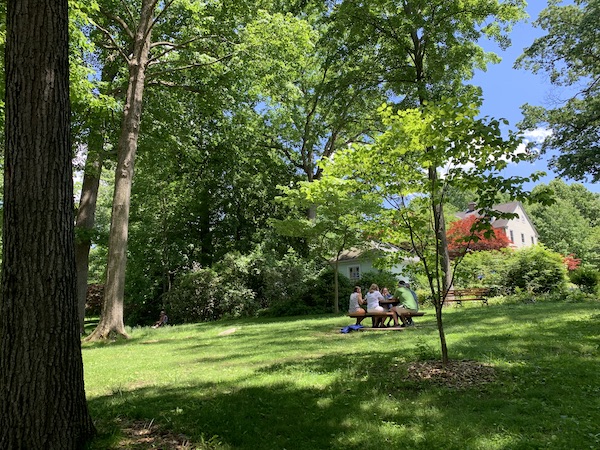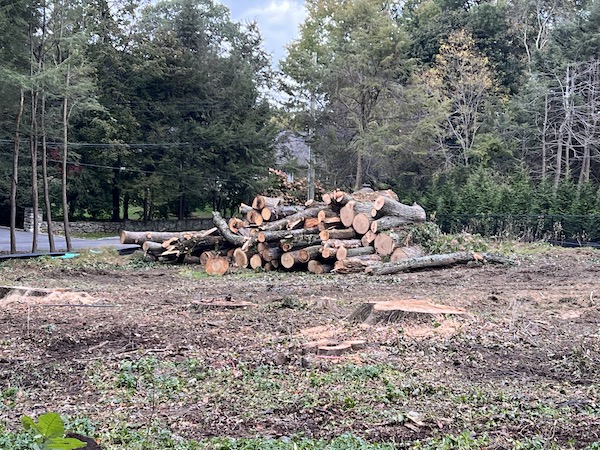CAC Finds That Scarsdale is Losing Its Tree Canopy
- Category: On Our Radar
- Published: Saturday, 16 December 2023 15:16
- Joanne Wallenstein
 At the opening of the Village Board meeting on Tuesday night, the Scarsdale Conservation Advisory Council (CAC) presented an update on the Village's tree code amendments that were enacted in 2018 and 2019. According to the CAC, only 33% of trees removed are being replaced. The CAC highlighted the impact this low replacement level will have on the future aesthetics of the community as well as the impact to stormwater and erosion control since trees soak up a significant amount of stormwater.
At the opening of the Village Board meeting on Tuesday night, the Scarsdale Conservation Advisory Council (CAC) presented an update on the Village's tree code amendments that were enacted in 2018 and 2019. According to the CAC, only 33% of trees removed are being replaced. The CAC highlighted the impact this low replacement level will have on the future aesthetics of the community as well as the impact to stormwater and erosion control since trees soak up a significant amount of stormwater.
Included in the report are several recommendations for the Trustees to consider. According to CAC Chair Michelle Sterling, the existing code provides a framework to support maintaining our tree canopy and with appropriate enforcement of the code the village can maintain its Village in the Park setting.
Here is the report from the Scarsdale Conservation Advisory Council (CAC)
To: Mayor, Board of Trustees and Village Manager
From: Conservation Advisory Council
Re: Tree Code – Review/Analysis/Update Memo
Date: December 10, 2023
As part of the Tree Code updates adopted by the Village Board in 2018 and 2019, the Conservation Advisory Council (CAC) agreed to provide a review and analysis of the effectiveness of the code updates. With several years of data now available, the CAC has worked with the Village Engineering Department and Department of Public Works to review the data, discuss the impacts of the tree code updates, and consider how best to ensure the purpose and requirements of the tree code are followed. This memo provides an update to the Village Board.
Background: Over the past decade, the CAC and Friends of Scarsdale Parks (FOSP) have submitted to the village reports and recommendations regarding the protection of Scarsdale’s tree canopy and the proposed revisions of the tree code. In April 2018, the code was amended; those amendments included the reduction of the DBH of removed trees that require replacements from 36” to 24”; the addition of a requirement that all replacements be native to the Northeast United States; and, the mandate that a tree expert certify that a tree is dead, dying, hazardous or diseased before a permit is issued for its removal without a replacement requirement or fee. In February 2019, the code was amended to add an aggregate provision related to permits with multiple large tree removals in an effort to address clear cutting and other instances of significant tree removals.
Analysis: Data from tree removal permits indicates that only approximately one third of trees that are removed are being replaced. In 2021 there were 803 trees removed by permit and 308 replacements. It is important to note that this data does not include tree removals that are done illegally without a permit, with reports from community members regarding this occurrence. In addition to fewer trees being replanted than removed, an analysis of the tree permit data also indicates that the types of replacement trees are often a smaller type of tree which will often provide less communal benefits than the tree(s) being removed. Smaller trees provide less shade and absorb less stormwater. These trees were taken down in October, 2023 to clear the way for a new house on Cooper Road
These trees were taken down in October, 2023 to clear the way for a new house on Cooper Road
If Scarsdale wishes to maintain its tree canopy, proactive steps are needed to ensure that the intent and requirements of the tree code are followed. Several years ago the CAC did a study showing that Scarsdale has an approximately 50% tree canopy. The canopy is a beneficial asset to the community both environmentally and aesthetically. Moreover the importance of preserving our tree canopy is set forth in the legislative intent section of tree code. If Scarsdale continues to maintain a one-third tree replacement rate, and with trees that have less beneficial characteristics than the trees being removed, Scarsdale will look and feel like a very different town within the next decade. The CAC therefore believes that action steps need to be taken immediately to stem the current trend of significant tree loss and to maintain our tree canopy.
Action Items: The CAC believes that the following action steps, which are consistent with the existing tree code, will provide a meaningful impact to help ensure Scarsdale maintains its tree canopy.
● Enforcement of existing code: Continued enforcement of the tree code should be prioritized. While many homeowners and contractors obtain the necessary permits for tree removals, there continue to be frequent incidents of trees being removed without a permit. These illegal tree removals occur both during the week as well as on weekends, when village staff are not available and enforcement is handled by the Scarsdale Police Department.
● Enforcement / review of replacement trees: In addition to enforcement of tree removals, continued enforcement on requiring replacement trees and ensuring they are actually planted within one year should be prioritized. The type of replacement tree, ensuring a continued canopy for our community, is also an important part of the enforcement process.
● Arborist Review: The Village maintains a relationship with a consulting arborist that is able to review Tree Permit applications, especially permits that indicate a tree to be removed is dead, dying, or hazardous. These reviews should be prioritized to ensure the tree(s) being removed properly meet this section of the code as these trees do not require a tree replacement.
● Timeline of Landscaping Review (new homes and renovations): As part of the Board of Trustees review of the building process for new homes and major renovations, consideration should be given to incorporate the landscaping plans earlier in the review process for the BAR. Currently landscaping plans are reviewed at the end of the process and therefore the impact of a new home or renovation on the landscape cannot be fully considered.
● Modification of the tree permit form to include notice of removal: In order to facilitate village inspection of the tree removal site for village staff, the current tree removal permit application should require the applicant to notify the Village Engineer of the scheduled permitted removal no less than 48 hours prior to such removal.
The CAC thanks the Village administration and staff for their continued partnership and collaboration on the tree code and village tree plantings. Although not part of this review, it is appreciated that the Village DPW has made meaningful improvements to the Village’s tree planting program, including working with homeowners to plant trees in the Village Right of Way, planting trees on Village properties (e.g. parks), and most recently utilizing a state-run program to procure trees at a reduced cost. Although the Village tree planting program cannot be considered a replacement for planting trees on individual properties, it is an important part of maintaining Scarsdale’s tree canopy and should continue to be fully funded each year. The CAC fully supports, and asks the Village Board to likewise support, the DPW’s efforts to continue to expand the village tree planting program.
Footnotes:
DBH or Diameter Breast Height is a standard method of measuring a tree’s diameter to ensure a consistent approach to measuring the size of a tree. DBH is measured at 54’’ above the ground.
In 2017, the year prior to the first tree code amendment, it was similarly a 33% replacement rate: 874 trees were removed via permit and there were 297 replacements.
Section 281-1 Legislative Findings and Intent. The Village of Scarsdale finds that trees within the Village provide an important contribution to the health, safety, aesthetics and general welfare of Scarsdale residents and the community at large. Trees provide shade and aesthetic appeal, enhance green space, improve air quality, reduce energy use and atmospheric carbon dioxide, provide and promote habitat for wildlife, impede soil erosion, aid water absorption, inhibit excess runoff and flooding, provide screening, offer a natural barrier to noise, provide other environmental benefits and generally enhance the quality of life within the Village. These social, economic, and ecological benefits often increase as trees mature and the Village community's investment in trees has accrued over many years. This investment can be rapidly lost and is not easily nor quickly replaced due to the long length of time for a tree to mature. The destruction of and damage to trees and the indiscriminate and excessive cutting of trees can create barren and unsightly conditions, as well as surface drainage problems, increase municipal costs to control drainage, impair the value of real property and adversely affect the environment, health and character of the community. This article seeks to address these conditions and promote the preservation of trees within the Village.










